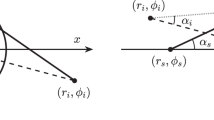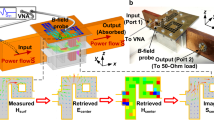Abstract
THE most famous optical medium furnishing a perfect optical image formation is the well-known ‘fish eye' of Maxwell1, the refractive index of which n(r) is given by the spherical distribution where A and a are constants. The trajectories are circles. Other media with ideal image formation have been found by W. Lenz2, and they are of the form The most obvious way of analogous construction of an ideal electron lens would be the realization of the corresponding potential by a spherical or axial symmetrical distribution of space charge3. This method is technically impossible, however, in the present state of development.
This is a preview of subscription content, access via your institution
Access options
Subscribe to this journal
Receive 51 print issues and online access
$199.00 per year
only $3.90 per issue
Buy this article
- Purchase on Springer Link
- Instant access to full article PDF
Prices may be subject to local taxes which are calculated during checkout
Similar content being viewed by others
References
Maxwell, J. C., "Scient. Pap.", 1, 74–79 (Solutions of Problems). For further literature, see Czapski, S., and Eppenstein, O., "Grundzüge der optischen Instrumente nach Abbe", 213–216 (Leipzig, 1924). Boegehold, H., on absolute optical instruments. Caratheodory, C., Sitzber. d. Akad. d. Wiss., Munchen, 1 (1926).
Lenz, W., in "Problems of Modern Physics" (edit, by P. Debye for A. Sommerfeld‘s 60th Birthday, 198 (Leipzig, 1928).
Gabor, D., Nature, 150, 650 (1942); Electronic Eng., 15, 295, 328 and 372 (1942–43). See also Cosslett, V. E., "Introduction to Electron Optics", 142 (Oxford, 1946). Gabor maintains in the above-mentioned papers that the ideal electron lens of Maxwell type (3) is unique in the three-dimensional case; this is in contradiction with the result (4) of Lenz. For the two-dimensional case, however, Gabor states that the solution (3) is not unique.
Watson, G. N., "A Treatise on the Theory of Bessel Functions", 453 (Cambridge, 1944).
Author information
Authors and Affiliations
Rights and permissions
About this article
Cite this article
GLASER, W. Maxwell‘s ‘Fish Eye' as an Ideal Electron Lens. Nature 162, 455–456 (1948). https://doi.org/10.1038/162455a0
Issue Date:
DOI: https://doi.org/10.1038/162455a0
Comments
By submitting a comment you agree to abide by our Terms and Community Guidelines. If you find something abusive or that does not comply with our terms or guidelines please flag it as inappropriate.



